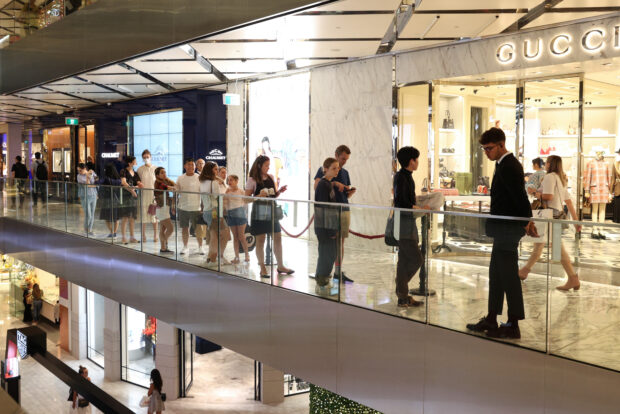Australia’s economy slows to a crawl, consumer spending surprisingly weak

Holiday shoppers stand in line inside a mall in the city centre of Sydney, Australia, Dec 17, 2020. REUTERS/Loren Elliott/File photo
SYDNEY – Australia’s economy barely grew in the third quarter as exports flagged and households – reeling from a surge in mortgage payments – were reluctant to spend, suggesting rate hikes were working to restrain demand.
Marking an eighth straight quarter of growth, albeit its slowest in a year, real gross domestic product (GDP) inched 0.2 percent higher in July-September from the previous quarter. That was short of forecasts of 0.4 percent and a result that bolsters the case for the Reserve Bank of Australia to no longer need to tighten.
Annual GDP growth stood at 2.1 percent, little changed from the previous quarter, the data from the Australian Bureau of Statistics showed on Wednesday.
“Australia’s economy hit the wall in the September quarter,” said Andrew Hanlan, an economist at Westpac, adding it was surprising to see just how weak consumer spending was during the quarter.
“The intense headwinds of high inflation, sharply higher interest and additional tax obligations are having a significant impact, leading to a sharp decline in real household disposable income.”
Article continues after this advertisementIndeed household spending was flat quarter on quarter and has barely grown for four quarters in a row, its worst stretch since the global financial crisis.
Article continues after this advertisementMortgage payments jumped by 28 percent from a year ago, the biggest increase in almost 50 years and the household savings ratio dropped further to 1.1 percent, its lowest level since 2007.
The slowdown is seen as a necessary consequence of monetary tightening by the Reserve Bank of Australia so that inflation can be tamed back to its 2-3 percent target range. Inflation was 4.9 percent in October.
The central bank on Tuesday opted to stand pat to allow more time to assess the impact of a whopping 425 basis points jump in interest rates since May last year.
Markets now figure that the RBA doesn’t have to hike any further, given the dovish turn from the Federal Reserve and European Central Bank in recent weeks, with aggressive rate cuts priced in for next year.
“The low level of the savings rate suggests that consumers may soon feel inclined to tighten their belts… We were sticking to our forecast that it (the RBA) will lower interest rates in the second quarter of next year, earlier than most anticipate,” said Marcel Thieliant, a senior economist at Capital Economics.
Net exports subtracted 0.6 percentage points from gross domestic product as prices for some commodity exports fell.
Productivity – in the measure of output per hour worked – increased 0.9 percent in the quarter after four straight quarters of declines. RBA’s forecasts of inflation returning to its 2 percent-3 percent target in late 2025 hinge on a pickup in productivity.